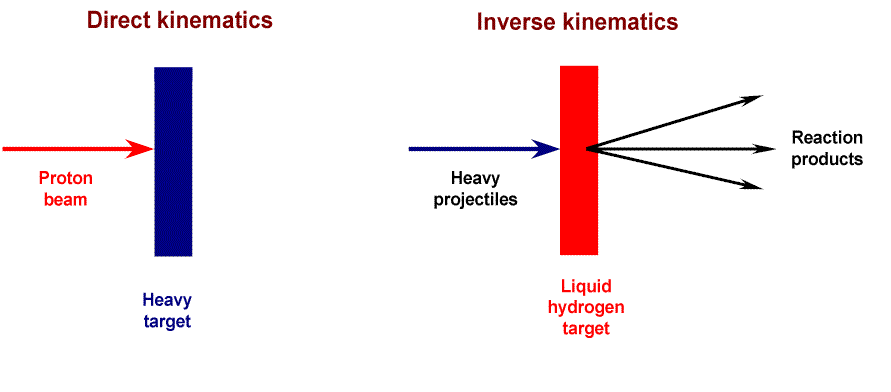
Inverse-kinematics method
The conventional experiments on residual-nuclide production in proton- and neutron-induced reactions are performed by bombarding various target materials with protons or neutrons of the energy of interest and by analysing the produced species after irradiation, e.g. by their radioactive decay or by off-line and on-line mass spectrometry. These methods can only give a limited insight into the reaction mechanism, because short-lived products, which form the dominant production in most cases, cannot be observed due to the time delay between the irradiation and the measurement. Information on the reaction kinematics is also not easily accessible. In addition, stable nuclides could only be detected with much effort e.g. by off-line mass spectrometry. The inverse-kinematics method is based on the bombardment of an hydrogen target with heavy projectiles. The reaction products are identified in-flight in mass and atomic number in a high-resolution spectrometer. At the same time, information on the reaction kinematics is available. When compared to the direct kinematics, the inverse-kinematics technique at relativistic energies has several advantages for the systematic measurement of production cross sections. Firstly, all nuclear fragments that originate from the projectile escape from the target, thanks to their high momenta. Thus, the outgoing fragments can easily be registered in-flight by suitable detectors placed behind the target. Secondly, the measurement is independent of the chemical properties and the beta decay of the fragments, which prevented detecting most nuclides by the radiochemical or activation methods used in many previous experiments. Thirdly, a measurement of residues velocities and angles, which are characteristic for the reaction mechanism, is possible for any value of the momentum induced, while experiments in normal kinematics suffer from a lower threshold below which the fragments do not leave the target or cannot be detected. Still, the use of the conventional techniques can provide very important complementary information on the energy dependence of the production of specific nuclides. Such information, which is extremely valuable for the understanding of the energy dependence of the different reaction mechanisms, cannot easily be obtained by the inverse-kinematics technique due to the large effort for performing and analysing these experiments. In addition, the experiments based on decay spectroscopy can give a direct measurement on long-term activation.
